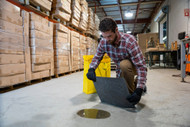5 Spill Kit Tips Every Plant Manager Should Know
Posted by EnSafeCo on 8th Feb 2021
Federal, state and local governments mandate immediate containment of all sizable spills presenting a danger to people or the environment. To help companies maintain a safe, OSHA-compliant facility,EnSafeCo offers a wide range of spill kits, facility protection, and safety storage products that meet location-specific requirements.
5 Essential Spill Kit Tips
1. Holding Spill Kit Training Programs
In addition to learning how to use spill kit items, employees should also participate in practice spill-control scenarios. By holding a mock spill emergency, plant managers and employees can identify problems in response times, proper use of spill kits and where improvement could be made to optimize their response.
2. Choosing the Right Spill Kit
The first step in choosing the right spill kit is selecting the correct absorbent materials. Universal spill kits include grey absorbents and will absorb all liquids. Oil spill kits contain white absorbents that are hydrophobic and will not absorb water. They are appropriate to clean up and remove oil-based solutions whether spilled on dry or wet floors. Facilities dealing with acidic or corrosive liquids should select chemical spill kits. Chemical spill kits include yellow absorbents which will withstand more toxic liquids. Companies such as ENPAC & SpillKit.com provide chemical, oil and universal spill kits that facilitate the ability of spill responders to efficiently and safely remove spills.
Another consideration in selecting a spill kit is the container type. Common spill kit containers include bags, drums, totes, cabinets, and other containers. How to choose the right spill kit container? Consider the size, mobility, and disposal requirements for your spill kit. Make sure your container is appropriate for the quantity of absorbents it must hold. If your spill kit is meant to cover a large portion of your facility, select a kit with wheels or a handle/strap for easy carrying. Other kits may be placed in areas where spills are very likely to occur and may not require mobility. Lastly, consider regulatory requirements for disposal of spilled liquids. Disposal of hazardous materials may require a salvage drum per regulatory requirements, so choosing a salvage drum spill kit combines clean-up & proper disposal.
3. Size of Your Spill Kit
It is important to have enough absorbent materials on-site to respond to the worst spill that your employees are trained to manage. This can be accomplished with multiple kits throughout the facility or a single large kit. It may be important to have location-specific spill kits dedicated to areas where frequent spills occur. For location-specific kits throughout your facility, make sure to obtain a spill kit large enough to accommodate at least one spill from your storage container. Most drums hold between 30 and 60 gallons while totes can hold up to 500 gallons. The spills from these containers can vary widely, so spill kits are available with absorption capacity from 1 gallon up to 150 gallons. If the possibility exists that abnormally large spills could occur, be aware that spill kits may be combined with drain covers and nonabsorbent dikes to channel fluids away from drains. Recovery of spilled liquids may be possible with pumps or vacuums.
4. Personal Protective Equipment In Spill Kits
Spill kits often include PPE, although these items will vary based on the size and type of spilled liquid. Industry-standard kits include basic PPE like gloves, goggles, and/or coveralls to prevent skin contact & protect the responder’s eyes. Other PPE in spill kits include face shields, respirators, aprons, & booties. Most spill kits are manufactured to be versatile rather than liquid-specific, so unless the spill kit is specially-designed (like battery acid kits), only the basic PPE will be included. A facility’s safety officer should assess stored chemicals and determine additional PPE required to adequately protect spill responders. In general, PPE should be kept in uncontaminated areas and protected by appropriate storage components. Spill responders should be trained in attaching PPE properly and quickly to address spills expeditiously.
5. Don’t Forget About Spill Containment
There’s no doubt that spill kits are an integral component of every spill response plan. The spill response plan will also include information to prevent spills before they occur. Secondary containment should be deployed in storage & dispensing locations. Common containment items include spill pallets, outdoor storage sheds, IBC containment, and wheeled containment options. During a spill event, active spill containment can be deployed in the form of drain covers & water-filled diverter dikes.
Contact EnSafeCo Today for Information About Spill Kits
EnSafeCo remains dedicated to providing superior products offering robust protection against toxins harmful to the environment and humans. We streamline transactions to ensure customers receive government-compliant products as quickly as possible. With multiple suppliers to choose from, our customers always find exactly what they are looking for at EnSafeCo. From containment pallets to spill kits to IBC and stormwater safety supplies, our industry-leading products are guaranteed to meet your needs.

